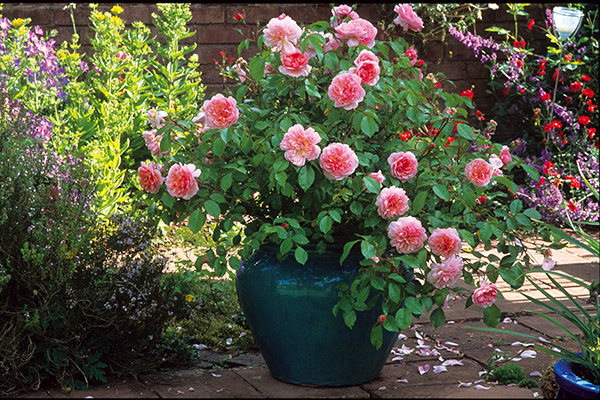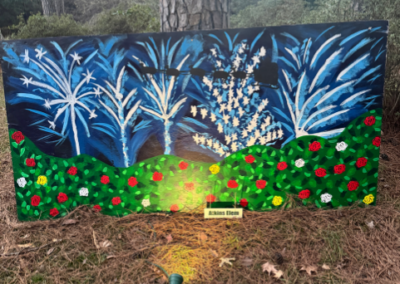This is a 2020 AOM winner

Ann Boleyn, courtesy David Austin
Most experienced rosarians know about the impacts of pH on nutrient availability in the soil. But what about the quality of your irrigation water? It has its own pH; plants can be negatively affected when its pH is extreme, 4.0 and below or 10.0 and above. Acceptable levels for plants of pH in irrigation water are between 5.5 and 7.5. Roses do best in soils at levels of 6.0 to 6.5, a slightly acidic soil. What impact does high pH of your water have on your soil pH levels?
For roses in the ground, there are many mitigating factors that temper the pH level of water, and there is more space for the water to dissipate and spread. But potted plants grow in confined soil where the buffering protection is limited. Everything that goes into the pot will have a more intensified effect on your plants as space in the pot is limited.
Water alkalinity
However, the alkalinity of your irrigation water is even more important to consider than its pH. Alkalinity in this case does not refer to pH levels; rather it is determined by the amounts of calcium, magnesium, or sodium bicarbonate in the water. These amounts will affect the overall pH, but their excess is what changes your potted plants soil. Here alkalinity is a concentration of several ions, such as calcium, magnesium, or sodium bicarbonate.
The effect of soil that is highly alkaline on rose plants in pots is similar to the effect of high alkaline soils in your garden. Important nutrients such as iron, manganese, and zinc become unavailable. Plant growth may be stunted, and leaf tips turn yellow and burn because of the high salt contents. Overall chlorosis (yellowing) may occur; manganese is important in chlorophyll production, the process that keeps leaves green.
The environment where your water originates is one of the biggest influences on its alkalinity. Mountainous areas and rocky soils are high in mineral content. Water draining from these areas absorbs these minerals and enters treatment plants at high alkaline levels, especially where there is little rainfall. Rain leaches minerals from the soil and tends to have an acidifying effect, resulting in water with less alkalinity. But in arid areas, minerals build up in the soil; the water that passes through these soils will pick up minerals, increasing alkaline levels.
Water analysis
In a water sample, all the ions that make up its alkalinity are combined and reported as calcium carbonate, CaCO3, the main component of lime. The ideal range for total alkalinity is 30-100 mg/L, but levels up to 150 mg/L are acceptable. High alkalinity (over 150 mg/L) can result in high pH in water; high alkalinity and high pH can cause problems with nutrient deficiencies or imbalances. In addition, high levels of these salts can result in soil impaction, water absorption, and plant health.
How can you determine the alkalinity of your irrigation water? Most water districts publish an annual report that details the components of your water. Some of these components are legally regulated by Maximum Containment Levels, such as fluoride and aluminum. Minerals such as calcium, potassium, and sodium are not regulated, but their quantities are usually included, along with a measure of water hardness, which is determined by the amounts of CaCO3 in parts per million. Akalinity is measured the same way.
In this sample, the District of Southern California water district reports alkalinity ranges from 69-74 parts per million, while hardness ranges from 124- 130 parts per million. Levels of pH are at 8.4 to 8.5. The water from this district could be considered to be hard and high in alkalinity as well as pH levels.
In contrast, the Trabuco Canyon Water District shows a pH of 6.9, alkalinity levels of 144 parts per million, and hardness of 200 parts per million. Here is an example of a lower pH level despite the higher alkaline amounts. The Trabuco Canyon Water district is located at the foot of the Santa Ana mountains, where the soil is full of the rocks eroded from the mountainsides. This results in hard water, water that will leave mineral deposits in pipes and on fixtures.
A research paper from University of Massachusetts Amherst, published in October of this year, details the upper and lower limits of irrigation alkalinity in container soils.
Container Minimum alkalinity Maximum alkalinity parts per million CaCO3 parts per million CaCO3
Seedlings or plugs 37.5 65
Small pots/shallow flats 37.5 85
4-5 inch pots/shallow flats 37.5 105
6 inch pots/long term crops 37.5 130
Using these standards, one can see that the Trabuco Canyon alkalinity levels of 144 ppm indicates water with a high amount of minerals. Potting soil with a large amount of peat would be helpful here.
Looking at the chart above, it is obvious that alkalinity in water will have particular impact on seedlings or plugs of baby plants. Distilled water may be a better choice for them.
While there’s not much you can do to change the chemical makeup of your water, you can help alleviate its impact. Potting soils high in peat content will offer some buffer; peat is acidic in nature. Fertilizers acidify soil, but nitrates leach out and leave minerals behind. Flushing pots completely with water every three to six months will dissolve minerals and also diminish salts in the potting medium. Using a solution of 1/2 to 2 tablespoons of vinegar in one gallon of water will raise acid levels in the soil. The type of vinegar is important; apple cider and white vinegar seldom exceed five to ten percent strength and are less likely to damage plants. Flushing solutions such as Clearex can be used to drench the pot until there is 20-40% runoff from the bottom of the pot.
Determining alkalinity levels of the water you use is hard to do without a water report. A hand held pH meter may show high pH levels when you test your pot with it, but alkalinity can occur at lower pH measurements. However, if the soil has a high pH level, you can be certain it is not too acid. Based on your knowledge of your water contents and the high pH reading, trying some measures to reduce salts and alkalinity in your potted roses won’t make your soil too acid.





























































